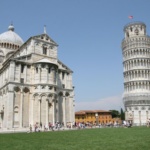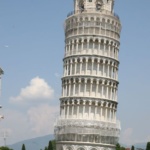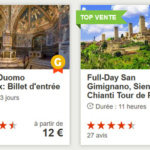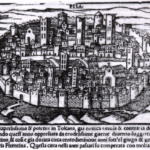The Piazza dei Miracoli of Pisa (Square of Miracles in English) is the wonder of the city, also called Piazza Duomo, listed as a UNESCO World Heritage Site for its architectural and artistic richness. It combines unique medieval and Renaissance constructions and ornaments, being at the origin of the style called Roman pisan which is exported to Tuscany, mainly to Lucca and Pistoia.
From the land of Mount Golgotha in Palestine, which would have been trampled by Christ, was brought here by the Pisan sailors in the Middle Ages. It was dispersed within a defined space, which became this sacred area.
The buildings were built here from the 11th century onwards, and the Piazza dei Miracoli became the symbol of the Maritime Republic of Pisa, one of the most important Mediterranean powers of the time.
Presentation
This Land of Miracles is located just outside the historic center, with its four majestic monuments, although none is vertical due to the very loose soil, with the Cathedral of Santa Maria Assunta begun in 1063 by the Opera della Primaziale Pisana (a secular-ecclesiastical organization), the baptistery, the famous leaning tower and the Camposanto.
She evokes the stages of life as a whole: from birth with the baptistery, to the cemetery with the Camposanto. The masterpieces include the bronze doors of the cathedral, the pulpits in the baptistery and cathedral, the frescoes in the Camposanto, etc.
The final appearance of the square dates from the 19th century when minor buildings were removed.



Pisa Cathedral
The Cathedral of Pisa Santa Maria Assunta was built in marble between 1064 and 1118. It is mainly of Romanesque architecture and initiated the so-called Pisan Roman style, merging classicism with various styles: paleochristian, arab, lombard and byzantine. His majesty symbolized the prestige of the Maritime Republic of Pisa, when it was at the peak of its power. It is also contemporary with the reconstruction of the St Mark’s Basilica in Venice
There was another building in the 10th century, but it was not well identified. The foundation in 1064 was traditionally made on the day after the victory of Pisa over Palermo. It was consecrated in 1118.
It has five naves with an apse and a transept.
The marbles of the exterior facing are of various origins, some from the Roman era.
On the front, the upper frieze of the first gallery is decorated with relief scenes of hunting.
The bronze portals were made by Florentine artists in the 17th century, while the San Ranieri Gate at the back of the bell tower was melted down around 1180 by Bonanno Pisano (the only one to escape the fire of 1595).



The central nave is separated by large monolithic granite columns with carved capitals from the 11th and 12th centuries. Triphores run over. The elliptical cupola above the cross is decorated with frescoes of the Virgin in glory and saints by Horace Riminaldi (1627-1628). The carved and gilded ceiling dates from the early 17th century. The stained glass windows in the central nave date from the 15th century and depict scenes from the Old Testament.
The magnificent pulpit was sculpted by Giovanni Pisano in 1302-10. Its nine panels represent episodes of the life of Christ, the Virgin and the Last Judgment. The shelves are carried by prophets and sybils, columns with capitals symbolizing the virtues of the Church.
The large mosaic in the apse represents Christ blessing the Virgin and Saint John the Evangelist (late 13th century).
Among the medieval works, a 13th-century Mary is attributed to Berlinghiero Berlinghieri of Volterra, the beautiful cosmatesque marquetry marquetry floor dates from the mid-12th century.






Pisa Baptistery
The baptistery of St. John the Baptist was built from 1153 and completed in the 14th century. It is the largest in Italy with a perimeter of 107 meters and a height of almost 54 meters.
The building is circular. It mixes Romanesque elements with the mainly Gothic exterior. The part up to the top of the first order arches was directed by the architect Diotisalvi, the following was followed in particular by Pisano. This exterior has a rich sculptural decoration especially in the tympanums. The portal facing the cathedral was decorated in the early 13th century with a Greco-Byzantine style.
The circular interior is supported by eight columns erected in 1163, with capitals featuring human and animal figures.
It houses the beautiful pulpit of Nicola Pisano, son of Giovanni, made in 1259-60. The seven columns are supported by lions and figures, scenes from the life of Jesus, etc.
In the centre, the baptismal font is the work of Guido Bigarelli of Como in 1246, with an octagonal basin, the floor in polychrome marble, etc.
The building is remarkable for its exceptional acoustics linked to the double dome, generating a particular echo.



Leaning Tower
The 55-metre high Tower of Pisa is an iconic symbol of Italy and is known all over the world. It has been leaning since its construction began in 1173. It was completed in the 14th century as the bell tower of the cathedral. It is a wonder that can be climbed thanks to its 294 steps.
It is lovely with its six-storey loggia.
→ See also the Leaning Tower of Pisa
Camposanto
The Camposanto closes the north of the Piazza dei Miracoli. It is a monumental cemetery built from 1277, the latest of the buildings in the Campo. It is structured in a cloister surrounded by a white marble enclosure, a form acquired in the fourteenth century.
It was intended to accommodate the sarcophagi and the many burials that cluttered the area. Archaeological objects such as Roman sarcophagi, which housed Pisan figures, can be found in the corridors of the cloister.
The main entrance is on the east side, decorated with a gothic tabernacle above the portal, a work from the second half of the 14th century.
The grand cloister has decorated pointed arches, and its walls are adorned with superb large frescoes begun in 1360, which are recovered since the damage of 1944. They evoke the themes of life and death, including Il trionfo della morte by Buonamico Buffalmacco, and Crucifixion by Francesco Traini.
The Aulla Chapel preserves the so-called “lamp of Galileo”. It also preserves rings of the great chain of the port of Porto Pisano which was broken by the Genoese after the defeat of the Meloria in 1284 (and brought to Genoa).







Where is the Places of Miracles, map
If you see this after your page is loaded completely, leafletJS files are missing.
Links and informations
- Official website : www.opapisa.it
- Tourist portal : www.turismo.pisa.it, www.patrimoniomondiale.it, www.terredipisa.it
- Informations : en.wikipedia.org
Posts about Pisa
- Pisa
 Pisa is a famous Tuscan city, famous all over the world thanks to its leaning tower, simply called Tower of Pisa, which has become one of the symbols of Italy, ...
Pisa is a famous Tuscan city, famous all over the world thanks to its leaning tower, simply called Tower of Pisa, which has become one of the symbols of Italy, ... - Things to do and see in Pisa
 You can spend half a day at Pisa if you only visit the Square of Miracles, but it would be a shame not to discover the rest of the city. ...
You can spend half a day at Pisa if you only visit the Square of Miracles, but it would be a shame not to discover the rest of the city. ... - Tower of Pisa
 The famous Leaning Tower of Pisa is located on the Square of Miracles (Piazza dei Miracoli), also known as Piazza Duomo. It is known worldwide as one of the emblems ...
The famous Leaning Tower of Pisa is located on the Square of Miracles (Piazza dei Miracoli), also known as Piazza Duomo. It is known worldwide as one of the emblems ... - Hotels in Pisa
 Book now an accommodation in Pisa, among hundreds of solutions, from the hotel to the apartment or bed and breakfast and agritourism in the surroundings
Book now an accommodation in Pisa, among hundreds of solutions, from the hotel to the apartment or bed and breakfast and agritourism in the surroundings - Visits and guided tours in Pisa
 Guided tours, reservations and entrance tickets to Pisa, including the Square of Miracles with the Leaning Tower, the Cathedral and other monuments Into the same category
Guided tours, reservations and entrance tickets to Pisa, including the Square of Miracles with the Leaning Tower, the Cathedral and other monuments Into the same category - History of Pisa
 Perhaps Ligurian or Greek at its origins, Pisa was then an Etruscan city, before becoming a Roman colony. The Romans built a port there, which was very active. It later ...
Perhaps Ligurian or Greek at its origins, Pisa was then an Etruscan city, before becoming a Roman colony. The Romans built a port there, which was very active. It later ... - Weather in Pisa
 Weather forecast in Pisa for the next days and weeks, sunshine and temperatures, air quality Weather forecast 5 days in Pisa Complete weather in Pisa Into the same category
Weather forecast in Pisa for the next days and weeks, sunshine and temperatures, air quality Weather forecast 5 days in Pisa Complete weather in Pisa Into the same category

No Comments Yet